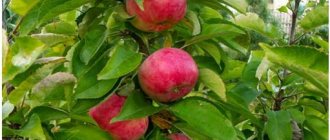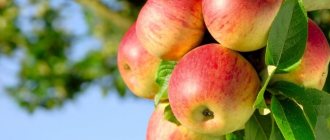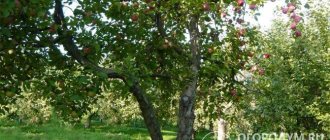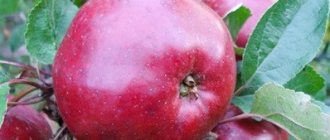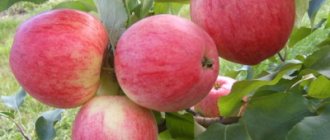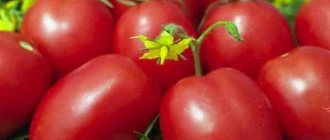Back in 1936, at the Samara Experimental Station, breeder Sergei Kedrin developed a new variety of apples. The Zhigulevskoe apple tree was obtained by hybridization. The parents of the new fruit tree were the “American” Wagner and the Russian variety Borovinka.
The plant was included in the State Register. Despite its advanced age, the Zhigulevskoe variety is still held in high esteem by gardeners. The Zhigulevskoe apple tree is an autumn variety and is widespread in many regions of Russia.
Description
Zhigulevskoye apple trees are grown in private gardens and even on an industrial scale. They are even suitable for growing in intensive gardens.
The plant is of medium height, but produces a fairly high yield. The tree itself prefers to grow in warm places, because it is not highly resistant to low temperatures. The apple tree must also be protected from codling moths and fungal diseases.
Variety characteristics
The Zhigulevskoye apple tree is distinguished by its regular structure. It has powerful skeletal branches, beautiful leaves and large flowers. But the main advantage and feature of this variety is still its fruits. They are large, can reach a weight of 200 grams. The skin color is yellow-green, but they are covered with a red blush and an oily coating. The fruits are beautiful, round, with a thick stalk.
Tasting assessment
The taste qualities of the Zhigulevskoe variety are so high that I would like to highlight them separately. The pulp is creamy, coarse-grained and very juicy, the skin is dense. The taste of the fruit is characterized as very sweet, with a slight sourness, which will add sophistication. Despite all their sweetness, the fruits are low-calorie, because they contain 87% water.
Self-fertility
The variety needs pollinating neighbors, because it is not self-fertile. Trees that will be good pollinators should grow in the garden or nearby, no more than 50 m.
The best autumn varieties are perfect for this:
- Anise gray;
- Kutuzovets;
- Antonovka vulgare;
- Kuibyshevskoe;
- Spartacus.
Only with high-quality cross-pollination will the Zhigulevskoye apple tree variety bear fruit well.
Tree height
The Zhigulevskoe apple tree can be considered medium-sized or semi-dwarf. Its height reaches 3 meters, no more. And although the yield is slightly lower than that of tall individuals, the compact size will allow planting to be denser, and therefore compensates for this disadvantage. The normal lifespan of such trees is 40 years.
Apple tree Zhigulevskoe.
Crown width
The crown of the apple tree is not thickened, the branches are quite sparse, rushing upward. Thanks to their structure, the sun's rays penetrate well into the crown to all the fruits and saturate them with taste.
At the same time, it lends itself well to shaping:
- massive and stable wide-pyramidal;
- neat, highly rounded, for small areas.
This structure allows you to reduce the time and effort required for pruning.
Root system
The roots of this variety must be healthy and resilient when planting for the plant to fully develop. They do not tolerate excess moisture, so it is better not to plant the tree in places where there is accumulation of moisture and close groundwater.
Winter hardiness
The apple tree is not particularly frost-resistant. She experiences stress due to temperature changes and thaws. The tree does not adapt well to winter frosts and suffers from the cold. Therefore, in conditions with extreme temperatures, Zhigulevskoye needs shelter and spring pruning.
Beginning of fruiting
Fruiting usually begins 4–5 years after planting, but it may shift slightly, because it all depends on a number of factors:
- rootstock varieties;
- climatic conditions;
- correct agricultural technology.
The fruit of the Zhigulevskoe apple tree.
But the sooner the tree begins to bear fruit, the sooner this period will end.
Flowering time
Flowering begins in mid-May, in some areas at the end. It is because of early flowering that the tree may suffer from May frosts.
Fruit ripening
The Zhigulevskoye apple tree variety is autumn or even late autumn. Fruit harvest, depending on the region of growth, may vary from mid-August to the end of September.
However, collection can be carried out in two stages:
- 2–3 weeks before full ripening;
- during consumer maturity, which occurs at the end of September.
Apples that are picked before ripeness have a longer shelf life. The variety is distinguished by the fact that it does not have a tendency to fall off. This is a huge plus, as part of the harvest is not lost.
Fruit storage
Without loss of taste, apples can be stored for about three months. However, this is only possible if you meet certain requirements:
- remove fruits from apple trees in dry weather;
- do not injure the skin and stalk;
- sort by size, do not store intact and damaged ones together;
- provide a temperature from 0 to +4 degrees.
Under these conditions, within three weeks the fruits will acquire the full spectrum of taste.
Productivity
The tree has an enviable and high yield. A typical tree can produce about 250 kg of fruit per season. Taking into account the fact that fruiting is annual, and the apple tree itself is of medium size – this is quite an impressive figure. Cyclicity is observed only in old trees of this variety.
Zhigulevskoe apple harvest.
Reviews from gardeners
Igor, 56 years old, Tambov region
This variety has been in our garden for almost eight years. Three medium-sized trees, strewn with delicious apples, are our breadwinners. We begin harvesting after September 10, but if the summer is dry and hot, then 1-2 weeks earlier. Despite our abnormal winters, the trees survive normally. The flower buds froze a couple of years ago. They did some pruning, fed them, and the Zhigulevskie trees recovered and started bearing fruit. From the first season after planting, we cover them for the winter every year. A month before the first frost, water the ground under the trees generously. We loosen the tree trunk circle and cover it with spruce branches. We whitewash the trunk and wrap it in burlap, at the same time to protect it from hares and mice. In winter, we place a snowdrift around the trunk. In the spring, we remove the snow and dig up the soil in the tree trunk circle, do sanitary pruning, and spray it against diseases and pests. In general, with such abundant harvests, there is not so much worry. We remove up to 200 kg from each tree. We mainly make dried fruits, juices, and closer to November we sell fresh fruits. Very tasty and profitable variety!
Polina, 36 years old, Tver
Our apple tree is about fifteen years old. We harvest at least 15 boxes per season. The apples are large, sweet, with a refreshing sourness. Delicious, smells like real apples. Once collected, they are stored until almost December. But the older the tree gets, the longer the breaks in fruiting occur: for a year, and sometimes for two. Unfortunately, in our region, during severe frosts, it froze several times.
Sergey, 54 years old, Nevinnomyssk
I planted Zhiguli apple trees at my dacha according to science: next to the pollinator - Antonovka. Now the trees have grown to 2.5 meters, the crowns are not dense, due to this they are well illuminated by the sun. I prune once a year in the fall to limit growth a little. The buds appear quite early, but in our warm climate they are not afraid of spring frosts. I usually start harvesting several times in August and until the end of September, since the apples ripen at different times. On average, it yields from 50 to 100 kg per tree. They are stored for no more than two months. In a good year I process it into juice. The apples are large, our largest was 235 g. When ripe: very beautiful, dark red. The taste is sweet, with a pleasant sourness, juicy. The skin looks a little oily. On the one hand, care is simple, but according to my observations, this variety does not like a lot of sun, the leaves begin to dry out, even watering does not always help. The codling moth that harms it the most is the codling moth. Needs to be treated with insecticides.
Features of planting and care
Although the variety is not particularly picky, there are a few care considerations to consider.
Deadlines
Planting can be done in autumn or spring. Both options have their place, but they also have their own nuances. It is worth taking a closer look at both methods.
Spring
Spring planting is preferable for northern regions. Throughout the summer, before the onset of frost, the seedlings will get stronger, and this will help them take root. Planting dates can vary from the last weeks of April to early May.
Autumn
Autumn planting will be especially advantageous for regions that do not experience severe frosts during the cold season. Over the winter, the tree will quickly settle down and become stronger, so fruiting begins a year earlier.
Technology
Planting a seedling of the Zhigulevskoye variety is no different from others. It is necessary to prepare the planting hole in advance, lay drainage at the bottom, sprinkle with soil, add fertilizer and make a hill. After the soil has settled, which will take approximately 2–3 weeks, you can begin planting.
Accommodation on site
The Zhigulevskoe apple tree needs cross-pollination, so they need neighbors. The distance between trees should be about 3.5-4 meters.
It is better to avoid planting in some places:
- proximity of groundwater;
- places where moisture accumulates;
- lowlands and places where there are gusts of strong wind.
It is best to choose a place on the south side of the site, where there is more sun. It is good that the area is protected from strong gusts.
Trimming
It is important to properly care for the tree and trim it correctly. This is the main rule for getting a good harvest.
Scheme for pruning an apple tree depending on the age of the tree.
Here are some requirements:
- When planting, the branches of the seedling need to be shortened by a third;
- every spring, remove damaged, weakened, diseased shoots;
- remove branches that grow inside the crown, fattening ones, and those located below the main branch.
However, it is very important to approach pruning wisely, not to remove more than a quarter of all branches at a time, so that the apple tree does not have severe stress.
History of apple breeding
This variety is of domestic origin. It was created in 1936 under the leadership of specialist S.P. Kedrina . To breed the crop, a hybrid crossing of the American variety “Wagner prize” with the ancient folk variety “Borovinka” was used.
For two decades, the Zhigulevskoye apple tree variety was subject to state variety testing, and only in 1965 was it officially registered in the State Register of the Russian Federation.
Types of rootstocks
There are several popular rootstocks on which Zhigulevskoye is planted.
Dwarf
The small tree produces only 40 kg of fruit per season. But it has a lot of advantages:
- the height does not exceed 2 meters, so maintenance is much easier;
- the compact crown allows you to plant more apple trees on the site;
- the harvest can be harvested within 3 years after planting;
- the taste of the fruit is not lost.
Thus, for those who have little space on their plot, a dwarf rootstock will provide delicious apples.
Semi-dwarf
The only difference when grown on a semi-dwarf rootstock is that a tree of this size requires additional attention when pruning. Growth is quite fast, it weakens only when fruiting begins. And to prevent the fruits from becoming smaller, it is necessary to regularly cut off the growth.
Columnar
Columnar trees have recently taken their rightful place in gardens. They are compact, easier to care for, and the quantity and quality of the harvest is not lost. However, unfortunately, the Zhigulevskoe variety is not grown as a columnar variety.
Zhigulevskoe apple tree on a columnar rootstock.
In which regions can it be planted?
The Zhigulevskoe apple tree is considered a variety of medium winter hardiness.
According to the State Register of Breeding Achievements, it is approved for cultivation in the Central, Central Black Earth, North Caucasus, Middle Volga and Lower Volga regions.
In more northern latitudes, for example, in the Moscow region, due to poor winter hardiness, the apple tree trunk may freeze.
This is the most vulnerable place of the tree, which requires good shelter for the winter. Also, in a harsh winter, flower buds on an apple tree may freeze.
In Eastern Siberia, it is possible to grow this apple tree in the form of stanza. This creeping form in winter allows the fruit tree to be covered with a layer of snow to protect it from frost.
Pollination process
The Zhigulevskoe apple tree is not a self-fertile variety, that is, it requires cross-pollination to set fruit. Therefore, in addition to this variety, other apple trees should grow in the garden. The best pollinators will be late autumn and early autumn varieties. To get the largest possible harvest, the following varieties should be planted in the garden :
- Kutuzovets;
- Anise gray;
- Spartacus;
- Kuibyshevskoe;
- Antonovka vulgare.
Expert opinion
Chernyaeva Tatyana Dmitrievna
Absolutely loves gardening and grows only organic vegetables
Ask a Question
Pollination will be successful and possible only when the distance between the Zhigulevskoye apple tree and the pollinating varieties is less than 50 m.

